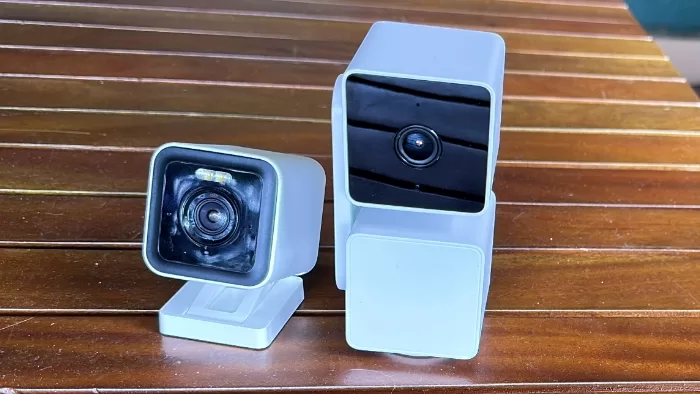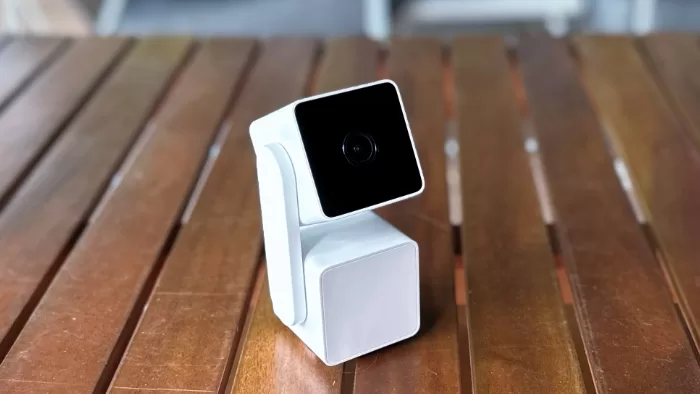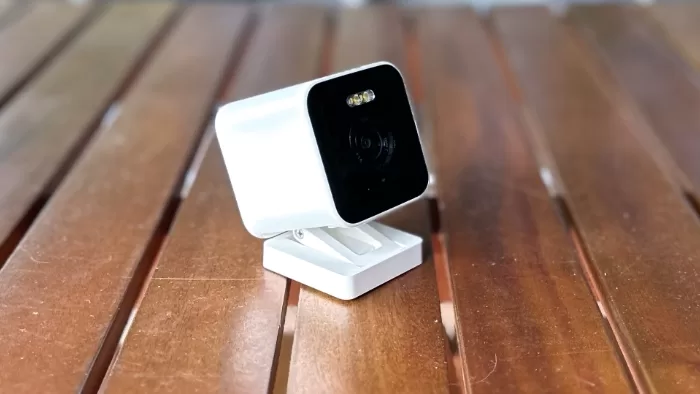The Wyze Cam v3 Pro and Wyze Cam Pan v3 security cameras do make it easy to monitor your home, and they’re nicely inexpensive. I do have some concerns about their long-term prospects, however.
Pros
Pan Cam folds down when in private mode
Good object tracking
Nicely affordable
microSD local card storage
Cons
Some object detection types require a subscription
Long term support picture is murky
Are they really secure? It’s hard to tell.
The field of home security cameras is full of high-priced options. You certainly can spend a lot just setting up a set of home monitoring cameras, and that’s not taking into account the monthly or yearly fees many charge for cloud-based incident backup and alert functions.
The Wyze proposition is a little different, targeting more the budget end of the market, but with the promise that they don’t skimp on features.
It’s a compelling argument if you want security on a tight budget, but like so many of these IoT cameras, you’ve also got to consider long-term security considerations around the cameras themselves.
Wyze Cam v3 Pro and Wyze Cam Pan: Design

There are essentially two schools of thought when it comes to smart home security cameras.
On the one hand, there’s the argument that you want really obvious cameras, because one clear way to keep miscreants behaving is to make it very clear that they’re being monitored.
On the other, there’s the argument that more subtle cameras are friendlier to home décor, as well as being less of a theft target in their own right. The Wyze camera design team clearly belongs to the second camp.
Also, they’ve got a thing for cubes. The smaller Wyze Cam v3 Pro is a small white cube on a stand, while the larger Wyze Cam Pan is… well… two cubes fixed together on a stand. They’re small, subtle and in a strange way kind of cute compared to your regular home security cameras.
Both cameras rely on simple USB charging for their power supplies, although one way that Wyze has kept costs down is by using the older microUSB standard.
That’s less of a concern for the Wyze Cam v3 Pro, because it’s got a standard socket, but the socket on the Wyze Cam Pan is very specifically shaped. If the cable breaks over time, good luck on finding a replacement that will fit neatly.
Both the Wyze Cam v3 Pro and Wyze Cam Pan support microSD local storage, with the v3 Pro doing a slightly better job of hiding where the camera storage actually goes. It’s underneath the camera, where the Pan Cam puts it on the side of the upper cube module.
Wyze Cam v3 Pro and Wyze Cam Pan: Installation and Performance

Like just about every smart home camera out there, both Wyze cams rely on an app for iPhone or Android. It’s the Wyze App (must have taken them ages to name that one), which uses the app itself and some simple QR codes that you show to the camera to install each of them.
I’m usually quite good at being the test case for something going wrong with this kind of approach, but for once installation really was quite seamless. The app allows you to set rules, motion zones and pretty much everything else that everyone else’s apps will let you do.
If you’re curious as to the difference between the v3 Pro and the Pan Cam, put simply, the smaller v3 Pro supports up to 2K video with smart focusing features and an integrated spotlight. It’s IP65 rated, which means it should be suitable for mounting outside, though you’d have to work out getting power to it in that case.
The Wyze Cam Pan, meanwhile rotates its camera, located on the top cube.It can rotate and tilt to track and take in more of its immediate surroundings, but at a relative cost of video quality, topping out at 1080p video. One cute factor here is that when you put it into private mode, it tilts the camera itself down, so it really can’t see anything at all. The v3 Pro just switches itself off.
Object tracking on the Pan camera is very good, although if you do put it near where you’re working, its constant tracking does become rather distracting. That’s not the point of course; you’re more likely to place it in an area where you want more distinct security coverage, or set a rule telling it that you’re home and to stop pestering you.
Both cameras can use either local storage – microSD card not included, so budget extra for one – or to the cloud.
Here Wyze doesn’t totally block you out if you’re not willing to pay for a subscription, but it does limit what you can do on the free tier. Without a subscription you get motion alerts and still pictures, but any level of video recording is off limits. What’s more, you only get those alerts once every five minutes, which leaves a lot of scope for miscreants to make off with your worldly goods.

The subscription tier is called Cam Plus, and it’ll run you $US1.99/month per camera, or $19.99/year, giving a fair discount for annual billing.
Cam Plus gets you unlimited cloud-based storage for up to 14 days, as well as motion, people, sound, person, package, vehicle and pet detection. That’s quite a list to hide all behind a subscription tier, but I suppose the flip side of that argument is that it’s also a fair amount to get for $US1.99/month – or roughly $2.96 in Australian dollars at the time of writing.
Actual video and still quality in most light conditions has been good throughout my testing time with the cameras. For privacy reasons I’m not putting that footage up here, however. One notable detail with the Pan cam is that its field of vision isn’t particularly wide. Naturally it can get around that to an extent by panning, but it does open the prospect of it not spotting movement in the first place.
All of this points to the Wyze cameras being decent value, but there’s a catch.
The catch – which, to be fair isn’t 100% specific to Wyze – is that you do have to weigh up the likely support life of the cameras themselves.
Put simply, the problem with this category is that over time, every manufacturer tends to stop supporting its older cameras. Developing the security patches needed to keep them secure costs money, and over time they all do tend to abandon older camera models.
And that’s if they bother to notify you that cameras are in fact in a place where they might be compromised. Sadly, Wyze fits into this particular category, having shelved an older camera rather than come clean with its users about some pretty serious security flaws in the v1 Wyze Cam.
To be fair, that’s not either of these products, and hopefully Wyze has learned its lesson and is keeping products up to date and secure, as well as notifying customers around end of life safe dates.
Wyze Cam v3 Pro and Wyze Cam Pan: Verdict

There’s a fair bit to like about the Wyze Cam v3 Pro and Wyze Cam Pan. If you need particularly sharp video then the v3 Pro might be your better bet, but the lower price of the Pan arguably makes it the stronger option for those looking for security on a budget.
However, with that budget — and again, this isn’t unique to Wyze, but it is a sold concern — comes the issue of how long these cameras might be supported for. It’s vital for anyone considering any home security camera to ensure that they’re staying on top of security patches, unless you like showing off what your camera is looking at to the world.
The Wyze Cam Pan will set you back around $70. You can order one through Amazon here.
The Wyze Cam v3 Pro will run you around $100, and you can order it through Amazon here.



